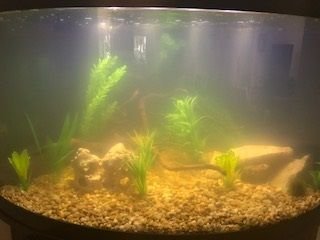My 90 gal corner tank has been up and running for about 2.5 weeks now, and the water has been slightly cloudy for about a week. Based on all of the cycling info I've read (and it's been a lot!), is my tank right where is should be? Do I just have to wait for the nitrogen cycle to complete itself? I'm getting impatient, and want to add fish!!
Here are the details:
I'm cycling with no fish and no live plants, with the intent to establish a cichlid tank (have had great success in the past)
Medium sized river rocks used for gravel
Running a Eheim Pro3 canister filter with a spray bar, 3 chambers of biological substrate, and a filter pad
Also running an Aqueon Circulation Pump 950
Used Seachem Prime to condition the tap water, and Fritz-Zyme Turbo Start
Added the recommended amounts of Cichlid Lake Salt and buffer (both from Seachem)
Temp is currently 82 degrees (300w heater)
Ph is 7.8
Water is very hard
Ammonia is 0ppm
Nitrite is between .25ppm - .50ppm (has been like this for about a week now)
Nitrate is 0ppm
Here are the details:
I'm cycling with no fish and no live plants, with the intent to establish a cichlid tank (have had great success in the past)
Medium sized river rocks used for gravel
Running a Eheim Pro3 canister filter with a spray bar, 3 chambers of biological substrate, and a filter pad
Also running an Aqueon Circulation Pump 950
Used Seachem Prime to condition the tap water, and Fritz-Zyme Turbo Start
Added the recommended amounts of Cichlid Lake Salt and buffer (both from Seachem)
Temp is currently 82 degrees (300w heater)
Ph is 7.8
Water is very hard
Ammonia is 0ppm
Nitrite is between .25ppm - .50ppm (has been like this for about a week now)
Nitrate is 0ppm
Attachments
Last edited:


